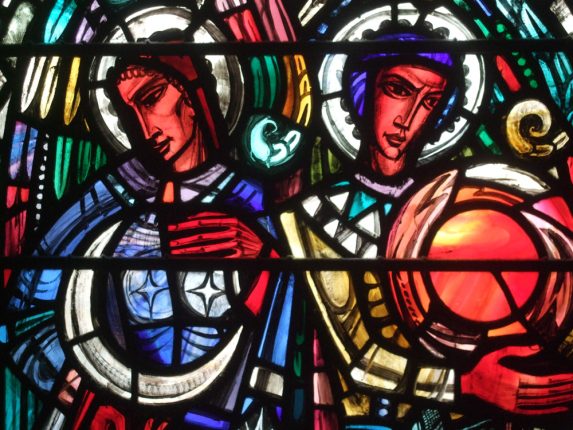6 - The Eric Liddell Centre, Edinburgh
Address
The Eric Liddell Centre, 15 Morningside Road, Edinburgh EH10 4DPTheme
Overview
This entry is part 6 of a 10 part essay by Douglas Hogg with the title “The Lion in the North – a 20th century lineage – A personally immersive account of the development and influence of a progression in the use of glass painting in Scotland as an expressive form, with particular reference to this as a unique and identifiable east coast phenomenon.” The full essay can be read in the themes section, where there are also links to each of the locations that are discussed.
Highlight
North elevationArtist, maker and date
William Wilson, 1957Reason for highlighting
William (Willie) Wilson began as an apprentice glass-painter at Ballantines of Edinburgh where his uncle worked as a glass-painter, taking evening classes in etching at ECA. He started up his own stained glass studio in the Dean Village in Phyllis Bone’s ex-sculpture studio (her sculpture guards the entrance to the Scottish War Memorial), taking on William Blair who had apprenticed in lead glazing at Cunningham’s of Edinburgh as his studio manager, bench worker and installer. Figuratively speaking, Wilson took on the basic form and composition of Hendrie but advanced this in his more fluid approach with respect to design, colour, paint and light. Like many of his predecessors he took an interest in current European art movements: two small panels in the collection of the Scottish Gallery of Modern Art reflect this. With a fluency of colour and open brushwork (he could paint a full window in a weekend when pressed) he moves away from the stiffer iconography of the Hendrie style. His superb mannered etchings of towns, villages and landscapes are shot through with a strong vision in dark and light and have a playful gestural perspective. His window in the Eric Liddle Centre in Edinburgh is a beautiful example of his best work. Once a church, a full internal structure now occupies the original void and so this work can now only be viewed in sections.
Elsewhere here there are many other examples of good work, including that of Chilton and Kemp, “Arsenic and Old Lace” whose studio bench worker was John Blyth’s father. Margaret Chilton had studied at GSA leaving in 1916. Making studio space for other artists by accommodating their projects could occur when help was necessary. The Chilton & Kemp studio accommodated, amongst others, John Duncan the painter and muralist who has a window here, a good Hendrie also being present. Wilson was prominent in Scottish Art circles. He was chairman of the boards of governors at the four Scottish Art Colleges, President of the Royal Scottish Academy, chairman of the Scottish Arts Council and a president of the Scottish Arts Club in Edinburgh. He went blind in 1962, after which John Blyth took over as the designer and painter. Observant onlookers will perhaps notice the stylistic change in installed works, drawings and cartoons but galleries experts and auction houses can’t seem to make the distinction readily.
At one point the Wilson studio took on Strachan’s main bench worker James Scullion (“Auld Scullion”) but only for a very short while. Never slow to rush to the door to tell all visitors that he had worked with the great Douglas Strachan, his studio coat caught one day on a stacked set of finished panels awaiting collection causing them to crash to the floor and sustaining much damage.
This is the sixth part of a 10 part essay, to continue reading please follow the link below
Part 7 – Church of St Mary, Haddington, East Lothian
Alternatively the whole essay, without pictures, can be read as a PDF here, or to go to the beginning of the essay click Part 1 – St Andrew’s and St George’s West Church, Edinburgh.
Artist/maker notes
William Wilson OBE (1905-72) was a Scottish stained glass artist, printmaker and watercolour painter. While working as an apprentice to James Ballantine II he had his eyes opened to the potential of stained glass when he saw Douglas Strachan’s scheme for the National War Memorial in Edinburgh Castle. He was a fine colourist, a talent that he developed across more than 300 church windows in Scotland. His career was tragically cut short by blindness in 1961, when he was also awarded an OBE.
Sources:
Scotland’s Stained Glass Making the Colours Sing by Michael Donnelly (Historic Scotland, 1977)
Images of broken light: William Wilson by Rona H Moody, The Journal of Stained Glass Vol XXX, 2006, pages 140-150
William Wilson on Wikipedia


Comments by
Douglas Hogg